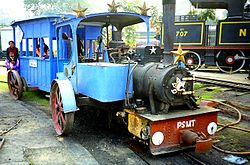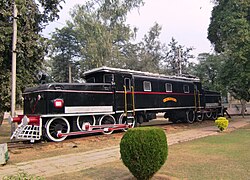National Rail Museum, New Delhi
This article needs additional citations for verification. (January 2019) |
 National Rail Museum entrance, New Delhi | |
 National Rail Museum entrance, New Delhi | |
Former name | Rail Transport Museum |
|---|---|
| Established | 1 February 1977 |
| Location | Chanakyapuri, New Delhi |
| Type | Rail museum |
| Website | nrmindia |

The National Rail Museum in Chanakyapuri, New Delhi, displays exhibits on the history of rail transport in India. The museum was inaugurated on 1 February 1977. The museum spans over an area of over 11 acres and the indoor gallery comprises an octagonal building which houses six display galleries and a large open area is laid out to simulate the atmosphere of a railway yard.[1] It is open every day except Mondays and national holidays.[2]
History[edit | edit source]
A Transport Museum was first proposed in 1962, under the advise of rail enthusiast Michael Graham Satow. The proposal took a concrete shape in 1970 and on 7 October 1971 the foundation stone was laid at the museum's present site in Chanakyapuri, New Delhi, by the then-President of India V. V. Giri.[3] The museum was inaugurated as the Rail Transport Museum in 1977 by Kamalapati Tripathi, the minister for public transportation.
The museum was originally intended to be a part of a larger museum that covered the history of railways, roadways, airways, and waterways in India; however, this never happened and it was officially renamed the National Rail Museum in 1995.[4][5]
Facilities[edit | edit source]
Auditorium: The museum has a state of the art auditorium with seating capacity of 200 persons.
VIP Lounge: The museum has a state of the art air-conditioned conference hall with seating capacity of 20-25 persons.
The Rails: The Rails is a restaurant situated in the museum. It is housed in a replica the Chhatrapati Shivaji Terminus main building. The restaurant depicts the formation of Indian Railways through unification of 42 independent railway companies held by the princely states of India and British East Indian Company. The Maharaja of Gwalior had a silver model train that ran along the banquet table and served food to the royal guests. The restaurant replicates this by making a steam locomotive chug around the restaurant and serve food at tables named after historic stations in the country.
Souvenir shop: There is a souvenir shop where small scale models of rolling stock, books, apparels, frame and prints, etc. are available for sale.
Exhibits[edit | edit source]
- Patiala State Monorail Trainways: This unique steam monorail was built in 1907. The train is based on the Ewing System and connected the town of Bassi with the city of Sirhind-Fatehgarh, approximately 9.7 km (6 mi) apart. This unique train system consists of a single-rail track on which the load-carrying wheel runs, while large iron wheels on either side keep the train upright. The train was built by Orenstein & Koppel of Berlin and ran until October 1927 when the line was closed. The engine and the chief engineer's inspection car remained in the railways' scrapyard where they were discovered by railroad historian Mike Satow in 1962. One of the engines was restored to full working order by the Northern Railway Workshops in Amritsar. The Chief Engineer's private inspection car was also reconstructed on an old under-frame. The two are now in working condition and are on display at the museum.[6]
- Fairy Queen: The world's oldest working steam locomotive in operational service. It is taken out on heritage runs several times a year.[7]
- Morris Fire Engine: built by the fire engineers John Morris and Sons Ltd of Salford, Lancashire, in 1914. The only other Morris-Belsize fire-engine known to exist is preserved by the Whitewebbs Museum of Transport, Clay Hill, London. It was converted to use pneumatic tires, while the fire engine runs on solid rubber tires.[citation needed]
- Electric locomotive 4502 Sir Leslie Wilson: This 1928 WCG-1 locomotive belonged to the Great Indian Peninsular Railway (presently Central Railway). It is one of India's first generation 1,500 V DC electric locomotives, which were known as khakis (English: crabs) since they make a curious moaning sound when at rest, and while in motion the linkage emits an unusual swishing sound. Its unusual features included an articulated body, which made it ideal for use in heavily curved sections of the Ghat mountains. The WCG-1 was in operation as a shunting locomotive until 1994 at Mumbai's Chhatrapati Shivaji Terminus.[citation needed]
- Electric locomotive 4006 Sir Roger Lumley: This WCP-1 locomotive has unique wheel arrangements. These locomotives were supplied by the Vulcan Foundry, UK, in 1930. They were electric locomotives operating under 1,500 V DC. They are known for hauling the Mumbai–Pune Deccan Queen Express in its early years. A prototype of this locomotive is also on display at the Nehru Science Centre in Mumbai.[citation needed]
- Fireless steam locomotive[citation needed]
- Steam locomotive A885 HASANG[citation needed]
- Steam locomotive X37385: This locomotive was used for trains to Ooty.[citation needed]
- Betty Tramways (Fowler Diesel): This locomotive ran in Rajkot and was owned by Rajkot-Beti Tramways.[citation needed]
- Saloon of The Prince of Wales: This saloon car was built for the Prince of Wales (later King Edward VII) for his visit to India.[citation needed]
- Saloon of The Maharaja of Indore: This was the saloon car of Maharaja of Indore.[citation needed]
- Saloon of The Maharaja of Mysore: This was the saloon car of the Maharaja of Mysore. The saloon is designed using teak, gold, ivory, and other materials.[citation needed]
- Crane tank[citation needed]
See also[edit | edit source]
References[edit | edit source]
- ↑ "History of the National Rail Museum". nrmindia.com. Retrieved 28 October 2018.
- ↑ LTD., C. C. Engineers PVT. "Visiting the National Rail Museum, Where, When". nrmindia.com. Retrieved 28 October 2018.
- ↑ "NATIONAL RAIL MUSEUM". nrmindia.com. Retrieved 28 December 2018.
- ↑ "Museum History". National Rail Museum. Archived from the original on 23 June 2017. Retrieved 4 July 2017.
- ↑ LTD., C. C. Engineers PVT. "NATIONAL RAIL MUSEUM". nrmindia.com. Retrieved 22 September 2018.
- ↑ "The Patiala State Monorail Tramway". irfca.org. Retrieved 29 October 2018.
- ↑ "8 reasons to take your child to National Rail Museum". The Indian Express. 4 July 2018. Retrieved 26 November 2018.
External links[edit | edit source]
- Official Museum Website
- Article on National Rail Museum, Delhi by Rangan Datta
- An Enthusiasts site
- Photographic tour
Coordinates: 28°35′05″N 77°10′53″E / 28.58472°N 77.18139°E



